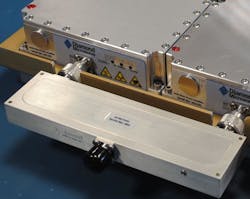Solid-state power was on display throughout the 2017 IMS exhibition, with a general industry trend towards packing more power into smaller packages. A long-time name in solid-state amplification, CTT, was at booth No. 519 with its lineup of low-noise and power amplifiers, including a number of broadband units such as a 40-W model for use from 6 to 18 GHz. When such broadband coverage is not needed, the firm can deliver 100 W or more at C-band frequencies.
Diamond Microwave, at booth No. 512, introduced two “smart” power amplifiers based on GaN semiconductor technology, 400- and 900-W units (see photo). The DM-X400-02 is designed for X-band use with more than 400-W pulsed output power over a 1,600-MHz bandwidth and almost 500 W output power over a 750-MHz bandwidth using 100-μ pulses at duty cycles to 15%. The 900-W unit combines two 400-W amplifiers with pulsed output power over a 5% bandwidth. The smart aspects of the amplifiers include monitoring of forward and reverse power, temperature, duty cycle, and operating current via an Ethernet connection to a computer. “We believe that these amplifiers still offer among the highest power-to-volume ratios in the industry for such products with such features and specifications,” noted Richard Lang, Diamond Microwave’s managing director. “They are particularly suited for providing a solid-state alternative to vacuum tube technology in radar and other demanding defense and aerospace applications.”
Showing what GaN can do at microwave frequencies, Wolfspeed, a Cree company, at booth No. 832, showed a GaN high-electron-mobility-transistor (HEMT) amplifier for use at 50 V dc. The amplifier is capable of 400 W pulsed output power from 5.2 to 5.9 GHz. Wolfspeed also teamed with Maury Microwave at booth No. 1536 to demonstrated high-power pulsed S-parameter measurements for developing computer-aided-engineering (CAE) models of its high-power devices.
In addition to several presentations at the technical conference, Ampleon was at booth No. 914 to show high-power devices based on different technologies: silicon LDMOS and gallium nitride (GaN). Using 32- and 50-V LDMOS processes, the company has achieved amplifier power levels of 400 W at S-band, 900 W at UHF, and 2 kW at ISM band frequencies.
For those who thought electron tubes were obsolete, Communications & Power Industries (CPI) was very much alive at booth No. 938 with its display of klystrons, traveling-wave tubes (TWTs), magnetrons, and other electron devices for truly high-power applications—especially for satellite-communications, radar, and electronic-warfare (EW) applications. The company, with many of the legacy designs from innovative leaders in vacuum electronics (such as Varian Associates), provides the devices capable of extremely high power levels for commercial, industrial, and military applications.
Included among the tubes was an industry-standard, the VKA-7910 klystron, with 500 W CW output power and 40-dB gain from 29 to 30 GHz. Not to be overlooked, CPI also brought examples of its solid-state amplifiers to the exhibition.
About the Author
Jack Browne
Technical Contributor
Jack Browne, Technical Contributor, has worked in technical publishing for over 30 years. He managed the content and production of three technical journals while at the American Institute of Physics, including Medical Physics and the Journal of Vacuum Science & Technology. He has been a Publisher and Editor for Penton Media, started the firm’s Wireless Symposium & Exhibition trade show in 1993, and currently serves as Technical Contributor for that company's Microwaves & RF magazine. Browne, who holds a BS in Mathematics from City College of New York and BA degrees in English and Philosophy from Fordham University, is a member of the IEEE.

